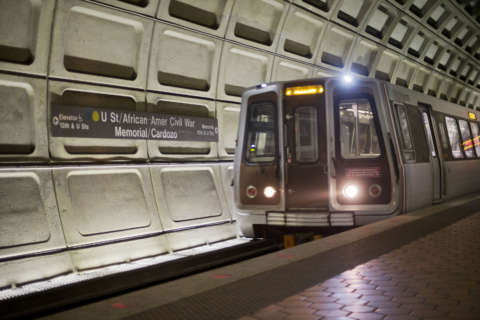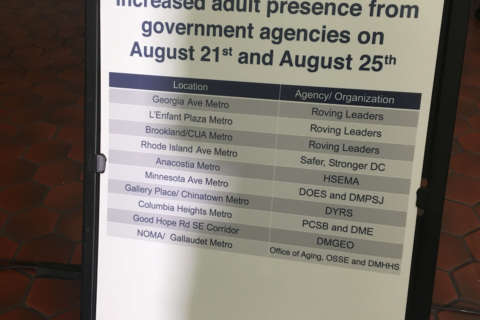WASHINGTON — Amid complaints that Metro’s fare evasion crackdown is leading to people being pinned to the ground or pepper-sprayed unnecessarily by police, Metro’s general manager said Thursday that the crackdown is necessary to ensure that other rules are followed and that Metro gets all of the funding it is entitled to.
“The way WMATA treats its riders, particularly people of color, is unacceptable,” Brianna Musselman told the Metro Board Thursday. She recorded video of a man being pinned to the ground and pepper-sprayed by Metro police at the Gallery Place station in June, during an encounter that began when officers said the man tried to enter the rail system without paying.
In a separate incident, Nnennaya Amuchie told the Metro Board, officers were unnecessarily combative with a group of mostly black teenagers when she was at the station last week.
“I met officers who were threatening to hit kids with their batons and to arrest kids because they were not moving down the stairs at the pace the officers would have liked,” she said.
Metro Board Chairman and D.C. Councilmember Jack Evans asked General Manager Paul Wiedefeld whether changes are needed to the focused fare evasion crackdown that began earlier this year.
“We don’t want this to escalate into something tragic,” Evans said.
Wiedefeld said just eight percent of stops initiated based on suspicion of fare evasion lead to arrests.
“A lot of times, it’s doing the background check on the person and we find issues … and sometimes these things elevate into something else if you resist or anything like that, or you do something against a police officer,” Wiedefeld said.
In other cases, riders get a warning or citation, and are told to pay the fare or leave the system. While the citation starts as a $50 fine, it could also lead to an arrest if the citation is not paid or challenged. The maximum penalty under D.C. law is up to $300 and 10 days in jail. A D.C. Council bill would eliminate the potential jail time.
Asked about the use of pepper spray or other force against people stopped for fare evasion, Wiedefeld said he generally backs his officers.
“I’m not going to second-guess what those police officers were up against in any situation. They’re trained; they’re professionals; they know what they’re doing,” he said.
Tap in, tap out
In addition to riders who are supposed to pay who do not, many D.C. school students still do not have the passes needed to ride the system for free properly loaded onto their school identification cards.
“We just can’t get people to take the cards, let alone use the cards,” Evans said.
The D.C. Office of the Chief Technology Officer said 64,643 public and charter school students had transit passes automatically added to their DC One Cards last school year, but that only about 19,359 students actually used the pass at least once.
In a news release earlier in the week, Metro said only 28 percent of eligible students this school year have an active pass. To activate the pass this school year, a student simply has to touch the card to a Metro farecard machine or bus farebox, then wait one to three days. Some students may need to tap the card twice.
Metro has officially extended the warning period for students through Nov. 12, and is sending letters and emails to parents through the school system reminding them of the policy.
Despite the wider effort, fewer than 5,000 additional students have activated the passes since the start of the school year. More than 16,000 students successfully loaded the passes in the weeks before school started.
While the students do not pay for the rail or bus rides taken using the pass, Metro loses money when students fail to tap in and out of the system. In addition to reimbursement from the District for the passes, nationwide federal transit formula funds are distributed based on official ridership numbers.
“Metro gets federal funding … based on ridership, and the only way we can prove ridership is if people tap their cards when they get on the system,” Evans said.
While Metro’s chief operating officer, Joe Leader, said earlier this year that the agency had no real way to know how many people use trains and buses without properly tapping SmarTrip cards or otherwise paying for their trips, Metro thinks fare evasion could theoretically cost the agency up to $25 million per year. The source of that estimate is unclear, but previous Metro estimates projected about 3.8 million D.C. school students alone walked around fare gates in the 2015-2016 school year.
Metro has begun locking emergency exit swing gates, and focusing on a “tap in, tap out” message.
“It’s not only for riders, but even employees, because we also want to know where our employees are,” Wiedefeld said.
On the bus system, where bus operators are wary of being assaulted by passengers over fare disputes, Wiedefeld said it’s important to keep fare evasion from becoming the norm.
Evans said the District and Metro must work together on some kind of solution.
“Clearly there is an issue between fare evaders and our police that I don’t want to escalate,” Evans said.







